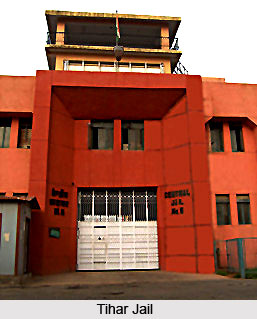 Tihar Prisons, also called Tihar Jail and Tihar Ashram, is known to be the largest complex of prisons in South Asia. Located at Tihar village, approximately 8 km from Chanakya Puri, to the west of New Delhi, the jail is very close the complex of Ashok Nagar. The prison is maintained as a Correctional Institution of India and its main objective is to convert its inmates into people with normal and healthy lifestyles. The anti socials of the society live here to be treated and guided by useful skills, education and rules. Tihar Jail is meant to improve the inmates` self-esteem and reinforce their desire to improve their outlook towards life and living. The items manufactured by the inmates of this jail bear the brand Tihar.
Tihar Prisons, also called Tihar Jail and Tihar Ashram, is known to be the largest complex of prisons in South Asia. Located at Tihar village, approximately 8 km from Chanakya Puri, to the west of New Delhi, the jail is very close the complex of Ashok Nagar. The prison is maintained as a Correctional Institution of India and its main objective is to convert its inmates into people with normal and healthy lifestyles. The anti socials of the society live here to be treated and guided by useful skills, education and rules. Tihar Jail is meant to improve the inmates` self-esteem and reinforce their desire to improve their outlook towards life and living. The items manufactured by the inmates of this jail bear the brand Tihar.
The original Tihar Jail was built on the site of Tihar village in 1958. Initially it was a maximum-security prison run by the State of Punjab. In 1966 the control was transferred to the National Capital Territory of Delhi. In 1984, addition facilities were incorporated in the agenda and the institution was renamed as Tihar Prisons. However, the earliest owner of Tihar Jail was Tevatia Jaats property. While Kiran Bedi was the Inspector General of Prisons, and had the Tihar Prisons under her own jurisdiction, she established a number of prison reforms, including a major change of naming the jail as Tihar Ashram. Kiran Bedi also instituted a Vipassana meditation program for the staff and inmates.
 Tihar Jail in association with NIC has developed unique Comprehensive Query-based system software for successful Prison Management called Prison Management System (PMS). This particular system keeps complete information about prisoners, their court cases and their accommodation pattern. It also records, follows and monitors the movement of prisoners and the actions taken after each of their court hearing.
Tihar Jail in association with NIC has developed unique Comprehensive Query-based system software for successful Prison Management called Prison Management System (PMS). This particular system keeps complete information about prisoners, their court cases and their accommodation pattern. It also records, follows and monitors the movement of prisoners and the actions taken after each of their court hearing.
First Time offenders ward is the reception ward of Tihar Jail in which prisoner who have been sent to prison for the first time, live for six months. This ensures their separation from the long-term prisoners lodged in other wards. High Security Ward has the prisoners who are involved in multiple offences or terrorism activities and are under constant supervision of Prison Staff and para military forces. Separate prison is reserved for women inmates with the allowance of crèche for keeping children below 6 years of age. Another Separate prison is kept aside for keeping adolescent prisoners between the age of 18-21 years.
There are 1746 sanctioned posts for the Tihar Jail prisoners. Jail Superintendents and Director General (Prisons) regularly conduct Sampark Sabhas for quick solution of staff grievances. The newly recruited Prison Staff undergoes comprehensive training at Delhi Police Training School/College. The Tihar Jail prisoners have the facilities of vocational training in the field of stitching, Computer Education, embroidery and so on. In addition, there is facility of Community Center; ATM, Extension branch of Bank, Gas Agency, Library, Primary School and Fair Price Shop. Medical facilities are provided for the prisoners through DGEHS dispensary located within the Tihar Jail Campus. In addition, health camps for the staff and prisoners are organized at regular intervals. There is also an Insurance scheme namely "Sarangi Scheme" for the Tihar Jail members at subsidized premium.






